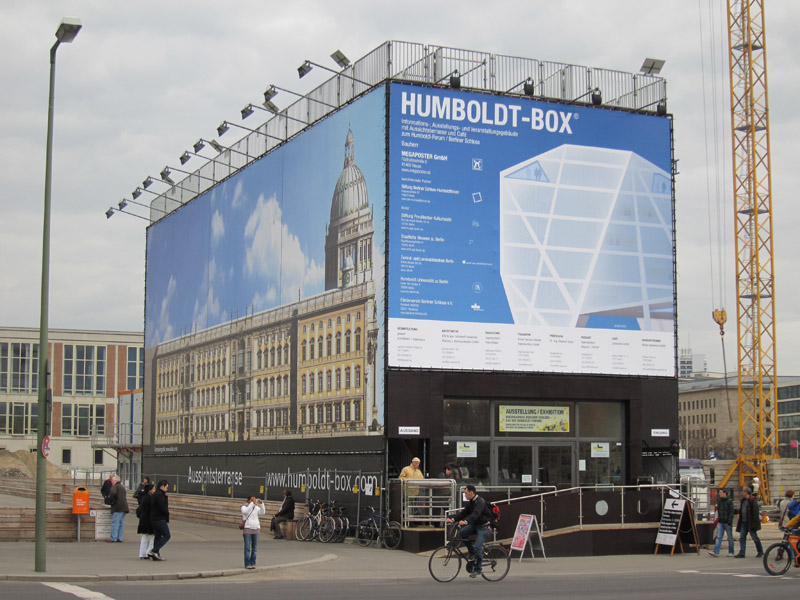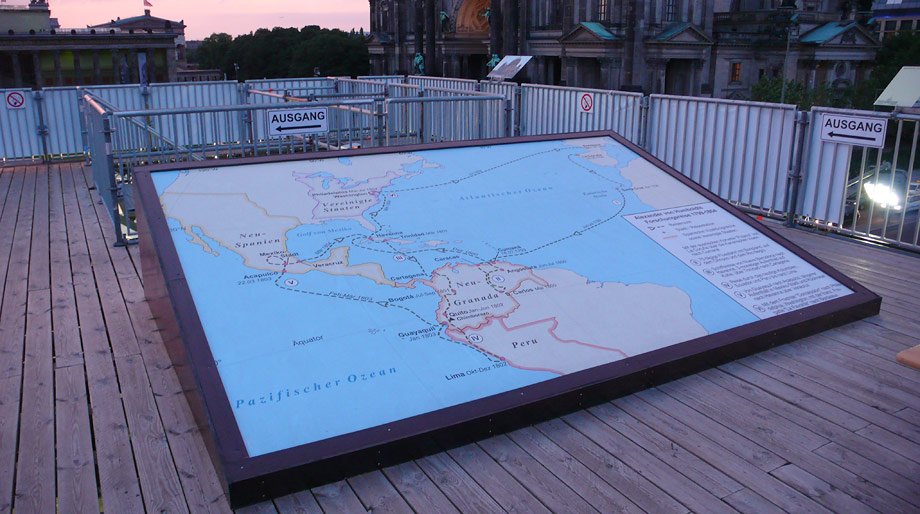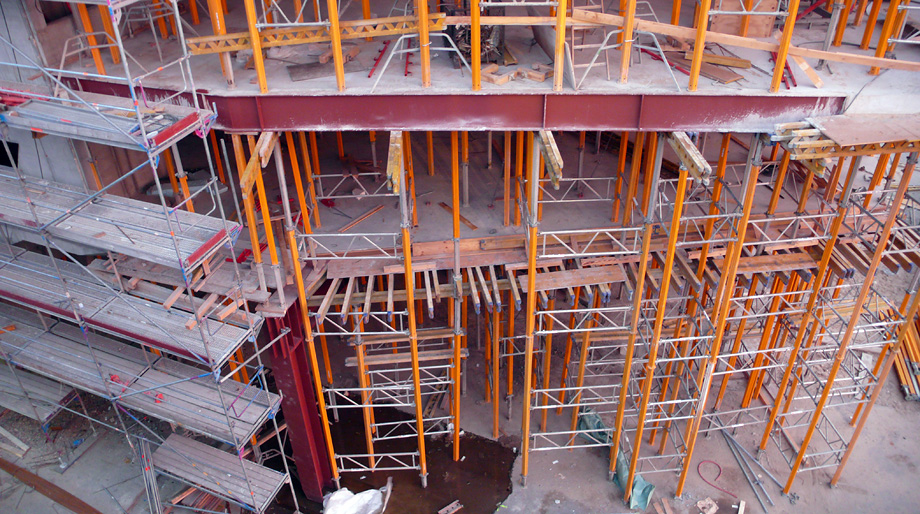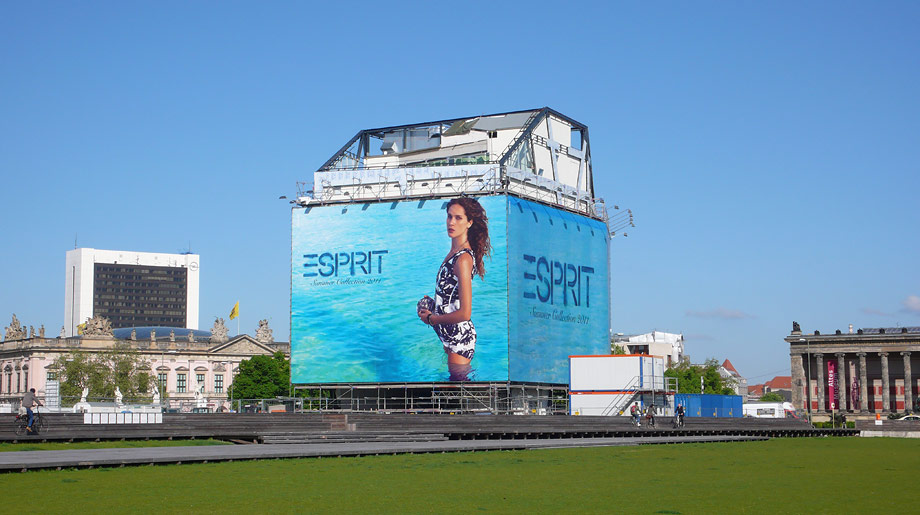Humboldt’s Gift
A year ago Slab colleague O.M. posted a rant about the Humboldt Box, a proposed viewing platform for a big hole in the center of town where a Prussian palace is to be built. Here’s a photographic reminder of what prompted him to ask if “you like your absurdity light and fluffy, or drenched in the heavy gravy of tradition?”:

O.M.’s article was based on the assumption that Berlin had intended to build some kind of Seattle public library rip-off (shown on the façade), but was too strapped for cash and ended up defaulting to a scaffold box with some decorative tarpaulin wrapped around it. His sardonic appeal to the reader was, however, about to bite him on the ass because the true absurdity of the situation was a magnitude or two greater than could be accomodated by his dualistic fluff/gravy continuum.
In my comment response to his article, I pointed out that the scaffold tarpaulin box was not a viewing platform for the building site of the future reconstruction of the Berlin City Palace (aka Humboldt Forum) – depicted on the side of the scaffold tarpaulin box – but a viewing platform for the building site of the future viewing platform for the future reconstruction of the City Palace depicted on the front of the scaffold tarpaulin box.
I’ll give you a second or two to digest that last bit before proceeding. In the mean time, here’s a picture of a cute lamb, soothingly bereft of absurdity.

About a week or so after O.M.’s article appeared, I visited the scaffold shortly before sundown. I was forced to pass through a turnstile which only opened once I’d grudgingly poked a 50 cent donation into its slot, thereby funding a gram or two of nostalgic Prussian misery. The ground-floor exhibition had closed shop for the day, so I was pretty much forced to ascend the scaffold to the roof, which inevitably is what a viewing platform is all about.
On the roof a map of Alexander von Humboldt’s Latin America expedition of 1799–1804 had been reproduced, using – incidently – source material taken straight from Wikipedia, and left uncredited in contradiction to the licence under which it was published. Not very scientific, and a saddening detail when one considers that the Berlin City Palace’s very purpose, as proposed by the Humboldt Forum project, is to unite the natural and social sciences under one roof. Citation needed indeed.
The view, of course, was spectacular. Ignoring the Berlin Cathedral or Alexanderplatz for a moment, and ignoring the picture-postcard sunset behind me, I was taken aback by the vast grassy plain below me. I’ve mentioned this inner-city mega-lawn before, but from up here it’s size was particularly striking. The only striking thing about the view of the Humboldt Box building site, was the staggaring number of supporting beams being used to prop up the slowly setting concrete superstructure.


View of viewing tower construction site, from viewing tower’s viewing tower
But, heck! What am I thinking? Here’s me relishing the absurd prospect of a viewing platform purpose built to assist in the viewing of the construction of a second viewing platform, completely forgetting that we live in post-interpretative times and that things are actually dead simple if you just relax and shut down most of your cerebral cortex. A quick check of the Humboldt Forum’s news ticker is relieving and revealing:
“[4.12.09] Humboldt-Box: Building work on the erection of the Humboldt-Box can be observed from an observation platform”.
Fantastic! No more explanation needed than those two clerical lines of reine Information, as beautifully unadorned as any 19th century telegraph message.
And all I needed to do was pay attention to the signs, of which there were plenty. All pointing to the exit – no less – to the outside, back to the street where a house-high rendering of the Palace, accompanied by a web address served to remind the onlooker that the edifice wasn’t commissioned by a romantic, philanthropic contractor, but by a company called Megaposter.
In February 2007 I coined the rather clumsy term “advertecture” to describe the increasingly common sight of buildings being engulfed by advertising to help fund their rennovation or repair. It was a crass but logical step up from regular billboards applied to regular buildings, and has helped the city save a big pile of money on several occasions. Megaposter arguably started the trend in 2000 by providing the wherewithal for Deutsche Telekom to swamp the Brandenburg Gate in trompe l’oeil DSL ads. Six years later they did the same for the lesser known Charlottenburger Gate, a neo-Baroque vanity project from 1909, which was falling into disrepair and in urgent need of a 3.500 sq meter Samsung advert.
The Humboldt Box though represents a full transformation from applied advertising to advertising as architecture. The information center, roof-top bar and faintly pompous sounding “agora”, as they’re calling the ground floor, are therefore only a fragment of the building’s real purpose: selling bikinis.
The imminent completion of the Humboldt Box couldn’t have come at a better time, or a worse one, depending on your point of view. This May, the Senate Department for Urban Development launched a set of guidelines which aim to improve lighting in the city, and also curb the spread of mega-verts. An outright ban a la São Paulo isn’t on the cards, and I wouldn’t exactly want it to be. Instead, the guidelines are based on an intricate study in which 20 different spatial and building types have been defined, and their sensitivity to 15 common forms of advertising have been gauged with a system of four colours ranging from red to green. A kind of traffic-light of advertising horrors, if you will. On a map published by the Senate, the area around the Humboldt Box has been labeled with an ominous orangy-yellow dot, meaning “sensitive”, on account of the historic ensemble of buildings surrounding it. That the advertising here is part of the same web of private and state interests surrounding the rebuilding of the Palace surely won’t have escaped the Senate. And making the situation rather more sticky for Megaposter will be last June’s decision to postpone the Palace’s construction for another three years.
Should the Palace never be built, then Humboldt’s gift to the city might just be some kind of protracted Champagne reception, hosted on the roof of a contemporary ruin, not yet paid for but too expensive to demolish, where the party is caught in an atmospheric limbo somewhere between birthday and funeral, and the drinks are constantly threatening to run out, but somehow never quite do.
